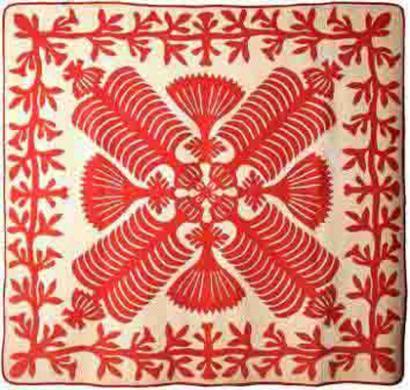
QUILT ART : PATCHWORK ART
FROM FEBRUARY 13 TO MAY 19, 2013
QUILT ART at Mona Bismarck American Center
QUILT - QUEEN KAPI’OLANI'S FAN, Beginning of the 20th century, Hawaï © American Museum in Britain
|
MONA BISMARCK AMERICAN CENTER FOR ART & CULTURE34 avenue de New York
INFORMATION:• Phone: + 33 (0)1 47 23 38 88 OPENING TIMES:Wednesdays to Sundays, 11:00 AM to 6:00 PM (except for holidays) ADMISSION PRICE:• Adults : 7 €
|
|
|
At 34 avenue de New York, a dynamic new site of American culture, the Mona Bismarck American Center plays a major role in strengthening French and American friendship and understanding through exhibitions, events and education. Following the fall 2012 exhibition of Mary Cassatt’s prints and drawings, comes a whole new register: decorative arts and textiles, as the MB American Center invites you to discover, from February 13 to May 19, 2013, QUILT ART: L’Art du Patchwork, an exhibition based on the textile collections of the American Museum in Britain. Presenting 25 quilts dating from the 18th to the 20th centuries, this exhibition represents a unique opportunity to celebrate the richness and diversity of the American tradition, as well as the originality and multidisciplinary of MB American Center programming. From the Rose of Saron to the Album Quilt, Friendship, Star of Bethlehem or Crazy Patchwork, and the very famous Hawaiian quilts, this show highlights typically American models and materials, rarely displayed in France. If the size of certain pieces emphasizes the virtuosity and patience of their creators, we also find symbols and details within the patterns evoking the political, economic, social and religious realities of their day. During the exhibition, visitors will have the opportunity to enrich their understanding of these works through a series of lectures with Géraldine Chouard, Professor at the University of Paris-Dauphine. Through workshops and demonstrations in partnership with France Patchwork (the largest and most important non-profit organization devoted to quilt-making in France), as well as quilting bees and discussions, visitors will find something new every Thursday in the MB American Center galleries. A series of musical performances inspired by the quilts will also take place during the exhibition – featuring American jazz, folk and acoustic music. The earliest quilts date as far back as sewing itself. There is evidence that the ancient world (Egypt, Greece, the Middle East) was already familiar with quilt-making, as it appears in the Bible – “Joseph’s coat of many colors,” for instance, an early example of patchwork. In Europe, the practice dates back to the Middle Ages, used for the Crusaders’ clothing and (padded) trappings that protected horses during tournaments. Banners were made according to the same technique and of course the Harlequin's costume includes two colored parts assembled together. When they immigrated to the United States, European communities brought with them their respective textile practices, which they adapted to the materials available. Heterogeneous in nature, the practice mixes Old World, locally-produced and other imported fabrics, such as silk, resulting in uniquely American styles, patterns and techniques. Located in Bath, England, the American Museum in Britain was founded by Dr. Dallas Pratt, an American psychiatrist and collector, and John Judkyn, a British antiques dealer who became an American citizen in 1954. Opened to the public in July 1961, the AMIB marked the culmination of a project to preserve and make known American decorative arts, so as to provide a better understanding of the history of the United States and its people. AMIB Curators Laura Beresford and Katherine Hebert, authors of the catalogue Classic Quilts from the American Museum in Britain, contributed to this exhibition.
|
||

